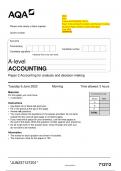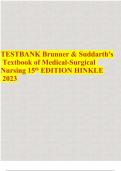Class notes
F214 Photosynthesis
- Course
- Institution
Directly answers criteria from the spec. Easy to read. Easy to revise. All you need to know. Neat and annotated diagrams. Cheap.
[Show more]Some examples from this set of practice questions
1.
State where the light dependent and light independent reaction take place.
Answer: Light dependent: on the thylakoid membrane Light independent: stroma
2.
Name the main photosynthetic pigment in Photosystem I and II. Give two accessory pgiments.
Answer: Main: Chlorophyll a Accessory: Chlorophyll b/carotene/xanthophyll
3.
What is the final hydrogen/electron acceptor in the light dependent reaction?
Answer: NADP
4.
How many NADPH and ATP are created from the non-cyclic light dependent reaction?
Answer: 12 of each
5.
How many ATP is needed for the light independent reaction? Outline how this is achieved?
Answer: 18 ATP are needed. Non-cyclic light dependent creates 12. 6 more are created by cyclic. The electrons in photosystem 1 and ferodoxin flit between each other, to maintain an electrochemical gradient, for more chemiosmosis to occur, for more H+ ions to drive the ATPase head and produce more ATP.
6.
What is a photosynthetic pigment?
Answer: Molecules that absorb light energy, from a range of wavelengths in visible regions and has own distinct peak of absorption. Other wavelengths are reflected.
7.
At what wavelength does Chlorophyll a absorb light?
Answer: In photosystem 2 - P680 nanometres In photosystem 1 - P700 nanometres
8.
What is photolysis of water? Explain it\'s importance.
Answer: Water hydrolysed to hydrogen ions, oxygen and electrons. Hydrogen ions are forced out to the stroma (for chemiosmosis) Electrons replace those that are lost by chlorophyll a, in photosystem 2.
9.
In the Calvin Cycle (light independent reaction), what catalyses the reaction between CO2 and Ribulose Bisphosphate (RuBP)? What do these reactants produce?
Answer: The enzyme Rubisco. GP is produced (Glycerate 3 Phosphate)
10.
What happens to the rate of photosynthesis if the temperature increases?
Answer: High - more kinetic energy = higher rate of photosynthesis Too high - denatures proteins = very low rate of photosynthesis Higher than 25 degrees Celsius - Photo-respiration occurs (part photosynthesis, part respiration) Rubisco binds to oxygen, instead of carbon dioxide. This produces phosphoglycolate, which is toxic. So it needs to be broken down to GP or organic compounds. So this slows rate of photosynthesis.

Stuvia customers have reviewed more than 700,000 summaries. This how you know that you are buying the best documents.

You can quickly pay through credit card or Stuvia-credit for the summaries. There is no membership needed.

Your fellow students write the study notes themselves, which is why the documents are always reliable and up-to-date. This ensures you quickly get to the core!
You get a PDF, available immediately after your purchase. The purchased document is accessible anytime, anywhere and indefinitely through your profile.
Our satisfaction guarantee ensures that you always find a study document that suits you well. You fill out a form, and our customer service team takes care of the rest.
Stuvia is a marketplace, so you are not buying this document from us, but from seller teepatel. Stuvia facilitates payment to the seller.
No, you only buy these notes for $3.90. You're not tied to anything after your purchase.
4.6 stars on Google & Trustpilot (+1000 reviews)
88731 documents were sold in the last 30 days
Founded in 2010, the go-to place to buy study notes for 14 years now

